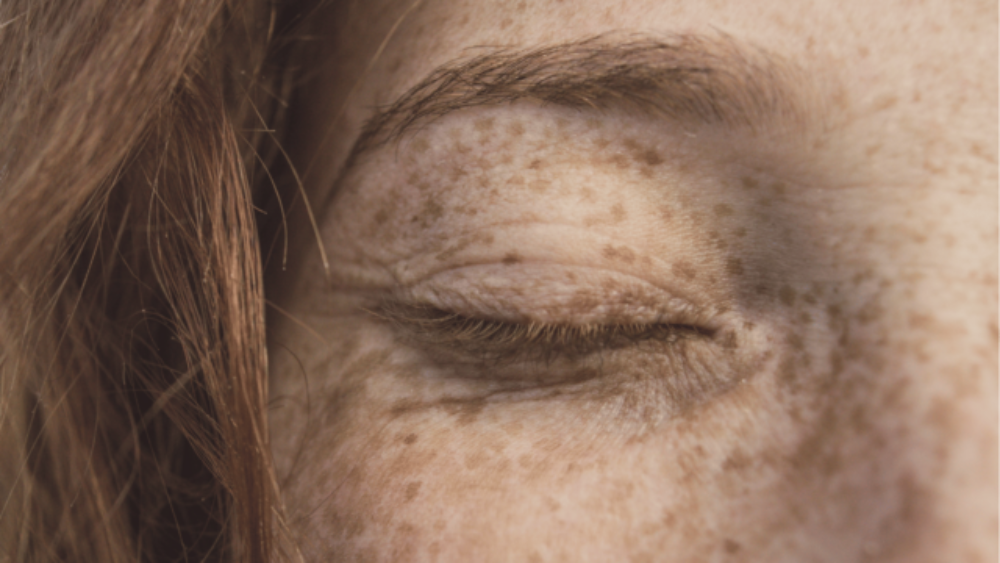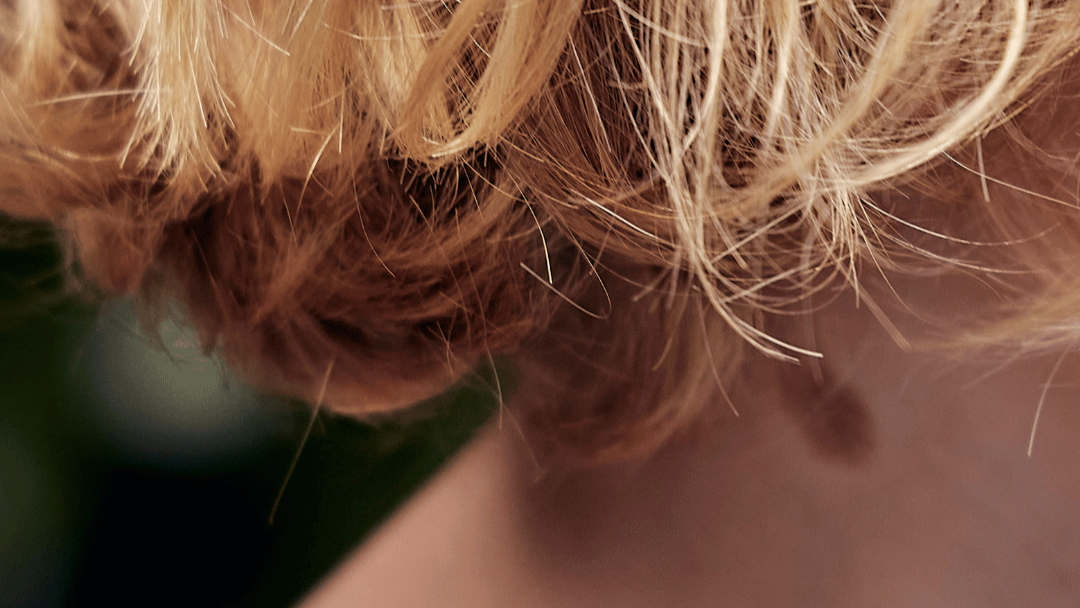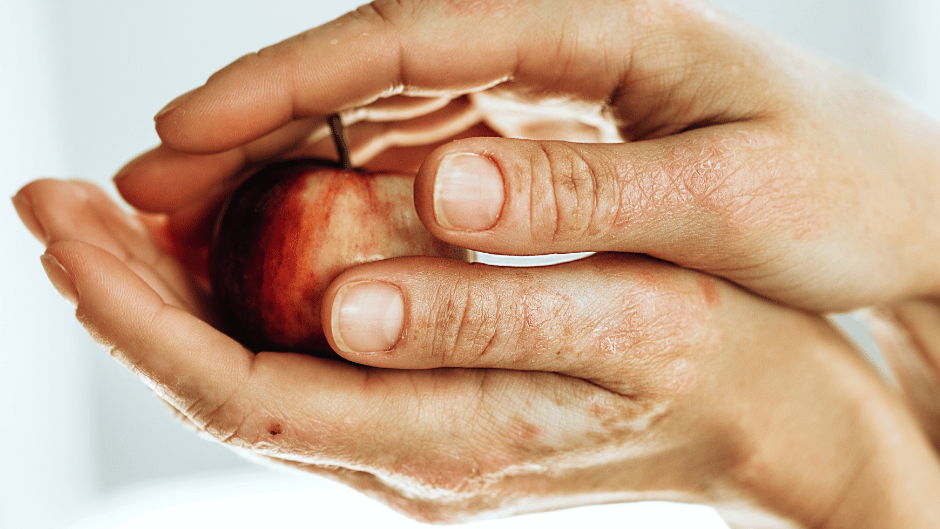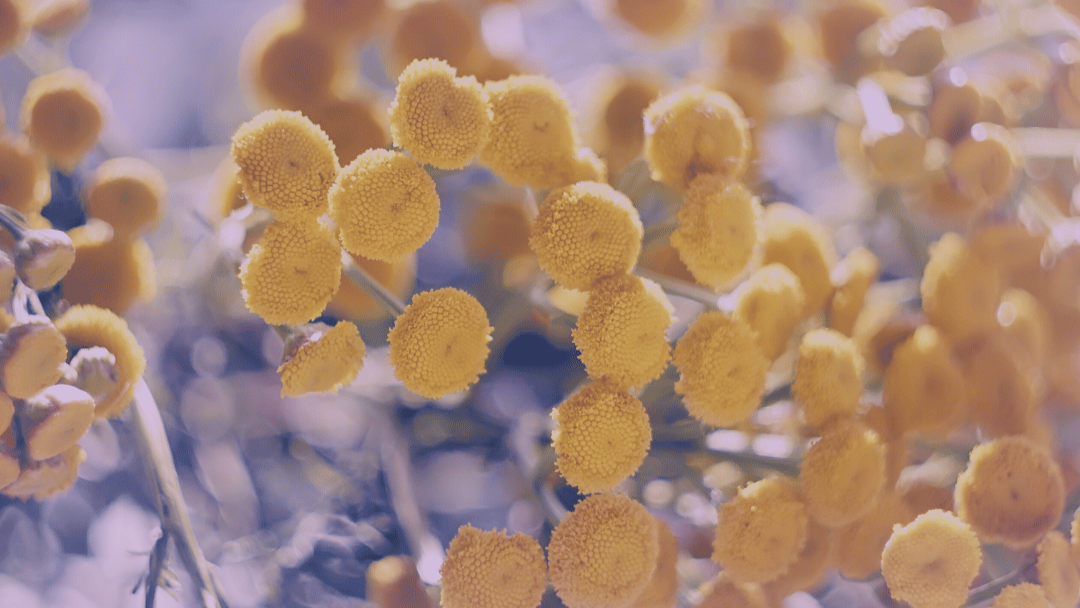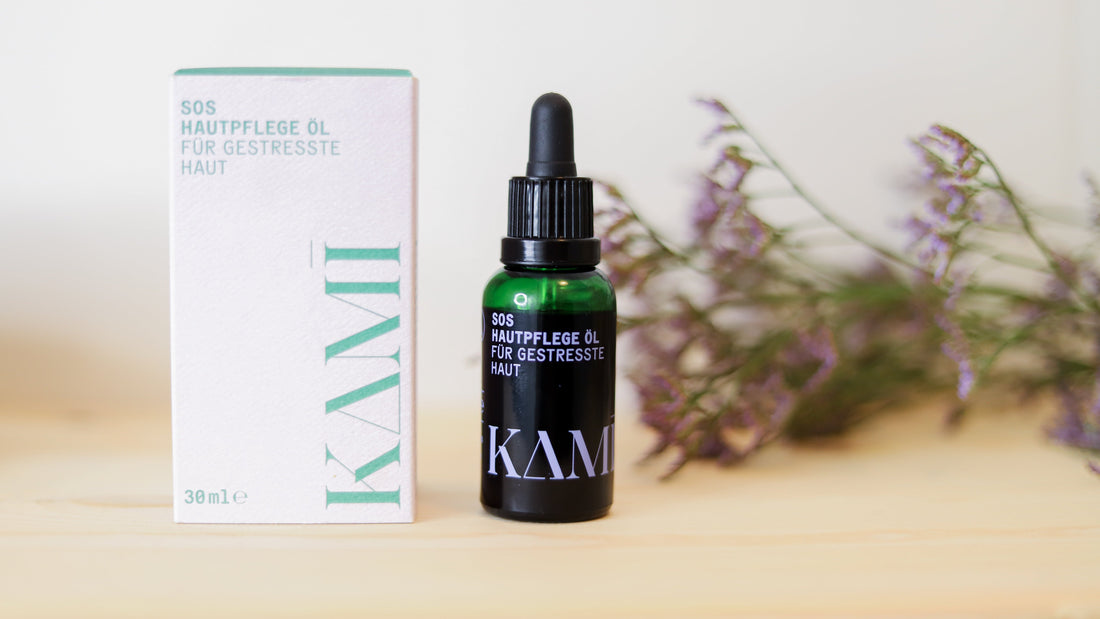KAMI SKINCARE BLOG
Kinderhaut im Herbst & Winter: Ursachen und Pflege trockener und juckender Haut
Kinderhaut im Herbst und Winter: Warum jetzt Pflege besonders zählt Wenn es draußen kälter wird und drinnen die Heizung läuft, reagiert empfindliche Kinderhaut schnell mit Trockenheit, Rötungen oder Juckreiz. Besonders Babys und Kleinkinder haben eine noch unreife Hautbarriere, die Kälte, trockene Luft und Reibung durch Kleidung schlechter abwehrt. Das begünstigt trockene Haut, Ekzeme oder Neurodermitis-Schübe. Erfahre in unserem aktuellen Blogbeitrag:🌬️ Warum die Hautpflege im Herbst und Winter so wichtig ist🩺 Welche Hautprobleme bei Kindern jetzt häufig auftreten💧 Wie Du mit einer sanften Pflegeroutine die Haut Deines Kindes schützt – inklusive Checkliste und Pflegeempfehlungen mit KAMI-Produkten 👉 Jetzt lesen: „Kinderhaut im Herbst & Winter: Ursachen, Symptome und Pflege trockener und juckender Haut"
Learn moreNeurodermitis aus Sicht der Ernährungsberaterin Romy Löffler
Ein Gastbeitrag im Rahmen unserer Kooperation mit Nutrischlau Neurodermitis ist eine komplexe, multifaktorielle Erkrankung – das bedeutet: Viele verschiedene Auslöser und Einflüsse wirken zusammen. Neben genetischen Faktoren, Umweltreizen und psychischem Stress spielt auch die Ernährung eine zentrale Rolle. Wer die Haut wirklich langfristig ins Gleichgewicht bringen möchte, pflegt deshalb am besten nicht nur äußerlich, sondern unterstützt auch von innen. Genau aus diesem Grund arbeitet KAMI skincare mit nutrischlau.de zusammen – einem Blog und Beratungsangebot, das sich auf ganzheitliche, alltagstaugliche Ernährung bei Hautthemen spezialisiert hat. Hinter nutrischlau steht Romy, selbst Mama eines Kindes mit Neurodermitis und zertifizierte Ernährungsberaterin. Sie kennt die täglichen Herausforderungen betroffener Familien nicht nur beruflich, sondern auch aus eigener Erfahrung – und weiß, wie wichtig individuelle, liebevolle Begleitung auf diesem Weg ist. In diesem Gastbeitrag teilt Romy ihr Wissen, ihre persönlichen Erfahrungen und praktische Tipps, wie Ernährung und Hautpflege Hand in Hand gehen können – für starke Haut und weniger Schübe. Was tun bei einem Neurodermitis-Schub? Tipps der Ernährungsberaterin von nutrischlau, Romy Löffler Ein Neurodermitis-Schub kann für Babys und Kleinkinder ebenso belastend sein wie für dich als Elternteil. Plötzlich scheint alles wieder schlimmer: Die Haut ist entzündet, dein Kind kratzt sich ständig, der Schlaf leidet – und oft auch die Nerven der ganzen Familie. In solchen Momenten ist es wichtig, die Situation schnell zu erkennen und gezielt zu handeln. Dieser Artikel zeigt dir, woran du einen Neurodermitis-Schub erkennst, welche Sofortmaßnahmen du ergreifen kannst und wie sanfte Pflege wie das KAMI SOS Hautpflegeöl die Haut beruhigen kann. 1. Anzeichen erkennen: Wie äußert sich ein Schub? Ein Neurodermitis-Schub kommt oft plötzlich – oder schleicht sich ein. Die Haut eines betroffenen Babys oder Kleinkindes durchläuft dabei unterschiedliche Stadien, die Eltern mit etwas Erfahrung gut beobachten können. Typische Anzeichen:• Knötchenbildung und trockene Haut an typischen Stellen (z. B. Wangen, Rumpf, Armbeugen, Kniekehlen)• Zunehmende Rötungen und Schuppungen• Sich steigernder Juckreiz (besonders nachts sowie beim Wickeln und Umziehen)• Kratzspuren und Verletzungen der Haut mit einsetzendem Nässen, Krustenbildung und Rissen in der Haut• Bei akuten Verlaufsformen Superinfektion mit akuter Entzündung und Eiterbildung sowie beeinträchtigtem Allgemeinbefinden (starke Unruhe, Fieber) Mögliche Auslöser für einen Schub:• Wetterumschwung (z. B. kalte, trockene Luft)• Schwitzen• Infekte, Zahnen, Beikoststart• Nahrungsmittelreaktionen (z. B. auf Kuhmilch, Ei, Nüsse)• Kontakt mit irritierenden Stoffen (z. B. Wolle, nicht geeignete Pflegeprodukte, Duftstoffe)• Psychischer Stress oder Veränderungen im Alltag Wenn du das Gefühl hast, dass dein Kind plötzlich „anders“ reagiert, unruhiger ist oder sich an bestimmten Stellen immer wieder kratzt – lohnt sich ein genauer Blick auf die Haut. Ein Schub bedeutet nicht, dass du alles falsch machst, sondern dass die Haut gerade besonders viel Unterstützung braucht. 2. Erste Hilfe bei einem Schub – was jetzt hilft Sobald du Anzeichen eines Schubs bemerkst, kannst du mit gezielten Maßnahmen sofort gegensteuern. Wichtig ist: Nicht alle Hautstellen brauchen das Gleiche. Je nach Stadium der Hautveränderung ist eine unterschiedliche Pflege nötig. Der Hautpflegesatz hilft dir dabei:• Feucht auf nässend: Wenn die Haut nässt, also Flüssigkeit absondert oder Verkrustungen bildet, helfen feuchte Umschläge (z. B. mit Schwarztee oder Kochsalzlösung) und Schüttelmixturen, um akute Entzündungen und Juckreiz zu lindern.• Fett auf trocken: Trockene, schuppige oder rissige Hautstellen brauchen fetthaltige Pflege, am besten ohne reizende Zusatzstoffe. Meist befindet sich neurodermitische Haut in einem Zustand zwischen diesen beiden Stadien. Die Herausforderung für dich liegt darin, eine abgestimmte Hautpflege zu wählen, die ein jeweils passenden Maß an Fett und Feuchtigkeit beinhaltet. Mit dem KAMI 2-Phasen-Pflegespray und dem KAMI SOS Hautpflege-Balsam hast du die Wahl zwischen einem leichten, feuchtigkeitsspenden und einem reichhaltigem, nährendem Produkt. Weitere Tipps für die Akutphase:• Verletzungen durch Kratzen vermeiden: Schlage dir aus dem Kopf, dass Kratzen deines Kindes vermeiden zu können. Diese Versuche werden scheitern und kosten euch beiden nur unnötig viel Kraft. Setze stattdessen in der Nacht auf Kratzhandschuhe oder spezielle Neurodermitis-Kleidung, um die Tiefe der Verletzungen durch das Kratzen zu reduzieren. (Weitere Informationen hier im Blogbeitrag.)• Sanfte Reinigung: In Akutphasen tägliches kurzes Baden oder Duschen mit lauwarmem Wasser, um die Keimlast zu reduzieren und Verkrustungen zu lösen. Für verschmutzte Stellen bei Bedarf KAMI Pflegendes Waschfluid zur Reinigung nutzen. Sanft abtrocknen und anschließend sofort passende Pflege auftragen. Alternativ kann das KAMI SOS Hautpflegeöl direkt in das Badewasser gemischt werden.• Luftige Kleidung: Baumwolle statt Wolle, keine engen Bündchen oder reibende Nähte. Unterhemden und Shirts ggf. vorübergehend auf Links tragen. Ernährung auf den Prüfstand stellen: Saures Obst (z. B. Zitrusfrüchte, Johannisbeeren, Ananas), starke Kräuter und Gewürze (z.B. Zwiebel, Knoblauch, Ingwer, Pfeffer) und stark histaminhaltige Lebensmittel (z. B. sehr reife Bananen, lang gereifter Käse, Konserven und sauer Eingelegtes) belasten die Haut in dieser Phase zusätzlich und sollten gemieden werden. Ruhe bewahren: Stress, auch deiner (!), überträgt sich auf die Haut. Achte auf einen ruhigen Tagesablauf und ausreichend Schlaf. Nimm dir regelmäßige Auszeiten und lass dein Kind durch andere Bezugspersonen betreuen. Stoppe konsequent negative Gedankenspiralen und richte deinen Wahrnehmung immer wieder bewusst auf die angenehmen Dinge eures Alltags. Achtung bei entzündeter Haut:Wenn du gelbliche Krusten oder Bläschen, eine starke Rötung und Wärme der Haut oder gar Fieber bei deinem Kind bemerkst, geh bitte sofort (!) zum Arzt bzw. der Ärztin. In solchen Fällen kann eine bakterielle Infektion vorliegen, die eine medizinische Behandlung notwendig macht. 3. KAMI SOS Hautpflegeöl – Sanfte Hilfe aus der Natur In der Akutphase eines Schubs kommt es darauf an, die Haut zu beruhigen, den Juckreiz zu lindern und die natürliche Hautbarriere zu stärken. Genau hier kann das KAMI SOS Hautpflegeöl eine wertvolle Unterstützung sein. Warum gerade dieses Öl?Das Besondere: Es enthält hochwertiges Murmelöl, das traditionell bei entzündlichen Hautzuständen eingesetzt wird. Murmelöl wird wegen seiner natürlichen entzündungshemmenden Wirkung oft als sanfte Alternative zu kortisonhaltigen Präparaten beschrieben – ohne deren Nebenwirkungen. Anwendung:• Direkt nach dem Baden oder Duschen sanft auf die noch feuchte Haut auftragen oder dem Badewasser beimengen.• Besonders geeignet für gerötete und stark juckende Hautstellen.• Auch für empfindliche Babyhaut – ohne Duftstoffe oder synthetische Zusätze. Viele Eltern berichten, dass sich die Haut schon nach wenigen Anwendungen weicher, entspannter und weniger gereizt anfühlt. Wichtig ist wie immer: Jede Haut ist anders. Deshalb zunächst an einer kleinen Hautstelle ausprobieren und beobachten, wie dein Kind darauf reagiert. Wenn du dir unsicher bist: Hol dir Unterstützung Gerade wenn sich die Schübe häufen oder du das Gefühl hast, im Alltag immer wieder an deine Grenzen zu stoßen, kann ein Blick von außen sehr entlastend sein: Welche Triggerfaktoren spielen eine Rolle? Hat mein Kind vielleicht eine Unverträglichkeit gegenüber bestimmten Lebensmitteln? Wie finde ich die richtige Pflege, damit wir die Haut endlich in den Griff bekommen? Ich biete dir über mein Neurodermitis-Soforthilfegespräch eine individuelle und schnelle Möglichkeit, die Situation mit einer Expertin zu besprechen, die das alles auch aus eigener Erfahrung kennt. Denn ich weiß: jedes Kind ist anders – und manchmal braucht es einfach ein bisschen Unterstützung von außen, um die nächsten und richtigen Schritte zu gehen. So kannst Du zu mir Kontakt herstellen: ich biete Gespräche und Begleitung an, hier findest Du mich: nutrischlau.de Ich teile meine Tipps aber auch über Instagram, folge mir! Danke für Deine Zeit, alles Liebe wünscht Romy Löffler
Learn moreThe connection between self-love, self-acceptance and atopic dermatitis
Dear KAMI skincare friends, Skin care is more than just applying oils, creams, and serums. Our skin is also a reflection of our inner state. Especially with skin conditions like atopic dermatitis, genetics aren't the only factor. This demonstrates the close interplay between mental health and skin health. Stress, negative thoughts, and a lack of self-love can exacerbate skin problems. But how exactly does mental stability affect our skin, and what can we do to support it? Currently, in time for Valentine's Day, KAMI skincare founder and general practitioner Dr. Kerstin Schallaböck summarizes how atopic dermatitis flare-ups can be influenced mentally. What connections are evident and are they proven? 1. Neurodermatitis and the influence of stress Atopic dermatitis, also known as neurodermatitis, is a chronic skin condition characterized by dry, itchy, and inflamed patches of skin. It affects millions of people worldwide and poses not only a physical but also a psychological challenge. The vicious cycle often begins with external stress: Psychologically demanding situations or stressful events can lead to an acute flare-up in people with neurodermatitis. But why is this? The answer lies in the way our body reacts to pressure or tension. In stressful situations, the stress hormone cortisol is released, which can intensify inflammatory processes in the body. In people with atopic dermatitis, this hormone can further damage the skin barrier and increase inflammation. A study in the "Journal of Investigative Dermatology" shows that psychological stress is one of the main causes of worsening symptoms in atopic dermatitis. This is also reflected in our current study with atopic dermatitis patients. 2. Self-love and self-acceptance as the key to soothing the skin Mental stability is crucial for minimizing the effects of stress on the body, especially on the skin. This is where the concept of self-love and self-acceptance comes into play. People who accept themselves and treat themselves with love have a lower stress response to stressful events. A study published in the journal Psychoneuroendocrinology has shown that people with higher levels of self-acceptance produce fewer stress hormones like cortisol and therefore also experience fewer skin problems. Self-love means accepting yourself with all your quirks and challenges, such as a chronic skin condition. With atopic dermatitis, it can be especially difficult to love yourself when you're constantly battling visible skin irritations and discomfort. But that's precisely when it's important to practice patience and mindfulness with yourself and to view your skin not as a "flaw" or "disorder," but as a part of your unique body. Acceptance is the first step to calming yourself and thus relaxing your skin (and your soul). 3. Self-Care: How to care for your skin inside and out Self-care isn't just a fad—it's a crucial component of skin health. It's about nurturing both your mental and physical health. If you're struggling with eczema, it's important to develop a holistic self-care regimen that addresses both your body and mind. Maintain a stress-free environment: Part of the self-care approach for atopic dermatitis is identifying and minimizing the sources of stress in your life. Regular meditation, breathing exercises, exercise, and yoga can help calm the nervous system and reduce cortisol production. Conscious body care, including conscious moisturizing and moisturizing, for example, with our delicate KAMI 2-Phase Spray, can also bring balance to the soul. Nutrition: Studies show that a balanced, anti-inflammatory diet can positively influence the symptoms of atopic dermatitis. Foods such as omega-3 fatty acids, antioxidants, and probiotics support the body in fighting inflammation. Topical care: Your skincare routine should be tailored to your skin's condition. For atopic dermatitis, it's crucial to choose products that soothe the skin, strengthen the skin barrier, and reduce inflammation. KAMI skincare products contain skin-soothing oils, shea butter, and aloe vera, all of which promote the development of a healthy skin barrier. Lavender oil and Tanais Annuelle oil also support this. Their scent is soothing, grounding, and creates a sense of calm, which has a positive effect on the skin's appearance. It's also important to avoid skincare products that could irritate the skin, such as those containing alcohol, mineral oils, or artificial fragrances. Scientific studies confirm the connection Scientific studies confirm that a positive mental attitude and stress management strategies have a measurable impact on the progression of skin conditions such as atopic dermatitis. A 2019 study published in the British Journal of Dermatology showed that psychological interventions such as cognitive behavioral therapy (CBT) and mindfulness training can significantly improve the progression of atopic dermatitis. These therapeutic approaches help reduce psychological stress factors, promote skin health, and improve patients' quality of life. To sum up: YOU can support your path to healthy skin! The connection between mental stability and skin health is undeniable. Self-love, self-acceptance, and a mindful self-care routine are crucial not only for your mental well-being, but also for your skin. Especially with chronic conditions like atopic dermatitis, it's important to take an approach that considers both the physical and mental aspects. When you're in tune with your mind, your skin will feel better—not just externally, but also internally. I hope I've given you a few reasons to accept and pamper yourself today on Valentine's Day. Celebrate yourself! All love Your Kerstin
Learn moreBathing and showering with atopic dermatitis skin – this is how it’s done correctly!
Dear KAMI skincare friends, Winter is the time when people enjoy splashing around in warm water, whether in the tub or a warm pool after skiing, sledding, or a walk. This is a pleasure that people with skin problems cannot indulge in without concern, as people are often warned against washing too frequently when suffering from atopic dermatitis and other skin problems. But we can reassure you: according to a meta-analysis of 13 controlled studies, daily bathing and showering does not affect atopic dermatitis if certain rules are followed. Today, we've put together some tips for you on how you can still enjoy water and always feel fresh and clean. All of our tips also apply to small children, although their skin is naturally even more sensitive and thinner. Atopic dermatitis is a chronic skin condition characterized by dry, sensitive skin. The skin barrier is compromised, which can lead to inflammation, redness, and itching. It's especially important to choose a gentle and nourishing skincare routine when it comes to personal care to avoid further stressing the skin. Our 10 tips based on current studies 1. Avoid hot water Hot water can further damage the skin barrier by dissolving the skin's natural lipids and drying it out. Studies show that baths and showers that are too hot can weaken the skin barrier and exacerbate inflammatory processes in skin conditions such as atopic dermatitis. Ideally, the water temperature when bathing or showering should not exceed 36–37 °C to avoid unnecessary stress on the skin. 2. Short shower and bath times Long baths or extended showers can also dry out the skin and damage its protective barrier. Studies, including a 2022 publication in the Journal of Dermatological Science, have shown that prolonged water contact causes skin to lose moisture. This can worsen the symptoms of atopic dermatitis. To avoid this, you should Limit shower or bath time to 5–10 minutes . 3. Avoid soaps and surfactants Traditional soaps and many cleansers contain harsh surfactants (detergents) that dry out the skin and disrupt its pH balance. A study in the "Journal of Clinical and Aesthetic Dermatology" (2021) suggests that soaps destroy the skin's natural acid mantle and make it more susceptible to inflammation and irritation. Instead, you should use mild, use skin-neutral cleaning products, that do not irritate the skin. Recommendation : The pH-neutral KAMI Cleansing Fluid is an excellent choice because it is free of harsh surfactants. It contains moisturizing ingredients such as peach kernel oil, which gently nourishes the skin and retains its moisture. Furthermore, the cleanser supports the regeneration of the skin barrier. 4. Use balneotherapeutic agents Balneotherapeutic products can help in the treatment of skin conditions such as atopic dermatitis. Products have anti-inflammatory effects and promote skin healing . A medical review in the "International Journal of Dermatology" (2020) explains that certain herbal ingredients, such as copaiba balm, have anti-inflammatory and skin-soothing effects and can thus support the healing process in atopic dermatitis. Copaiba balm promotes skin regeneration, reduces inflammation, and strengthens the skin barrier. Recommendation : KAMI Wash Fluid contains copaiba balsam, known for its anti-inflammatory and skin-soothing properties. This natural ingredient is a gentle way to care for the skin while reducing irritation. 5. Gentle cleaning instead of abrasion Avoid wash mitts or exfoliating products, as these can further irritate sensitive skin. A study in the British Journal of Dermatology (2023) confirmed that mechanical cleansing methods can often lead to skin injuries and worsen symptoms in atopic dermatitis. It is sufficient to cleanse the skin with your hands and pat it gently to protect the natural skin barrier. 6. Moisturizing directly after bathing or showering After bathing or showering, the skin is particularly receptive to moisture. Studies have shown that immediate moisturizing after cleansing strengthens the skin barrier and prevents dry skin conditions. A study published in the "Journal of the European Academy of Dermatology and Venereology" (2022) found that moisturizers containing lipids and ceramides support the regeneration of the skin barrier and reduce inflammatory processes. Recommendation : After showering, use a rich cream or lotion that intensively moisturizes the skin and contains soothing ingredients like shea butter or aloe vera. With KAMI skincare, you have three options: The KAMI SOS skin care oil can be added directly to the bath; just 1-2 droppers are enough. The oil spreads easily through the bathwater and onto the skin. Ideal for children who don't like to be rubbed with lotion! The KAMI SOS balm contains shea butter, which is very effective in treating atopic dermatitis. Apply to dry areas immediately after bathing, while the skin is still well moisturized. The KAMI 2-Phase Spray contains our highly effective KAMI oil blend as well as pure organic aloe vera gel. It intensively moisturizes, soothes the skin, and is quick and easy to spray on. 7. Pay attention to the pH value The pH of the skin is normally slightly acidic (around 5.5). This acidic environment protects against harmful microorganisms and helps maintain the skin barrier. Products that disrupt the skin's pH—such as overly alkaline soaps—make the skin more susceptible to irritation and infection. A study in the "Dermatitis Journal" (2021) has shown that Use of pH-neutral care products leads to better skin regeneration in cases of neurodermatitis. Recommended : Choose cleansers and care products with a pH that matches your skin's pH, around 5.5. Like our KAMI Cleansing Fluid. 8. Avoid artificial fragrances Artificial fragrances can cause allergic reactions or irritation in sensitive skin. Studies, such as a 2021 publication in the Journal of the American Academy of Dermatology, show that fragrances are a common cause of skin reactions in people with atopic dermatitis. It is therefore advisable to choose products without synthetic fragrances. Recommended : Like all KAMI products, KAMI Wash Fluid is 100% natural and free of artificial fragrances. We use natural, calming aromas like lavender and Tanais Annuelle. 9. Bath additives with refatting The use of moisturizing bath additives is particularly beneficial for dry and atopic skin. The "Dermatology Research and Practice Journal" (2022) states that oil baths containing skin-conditioning substances can retain moisture in the skin and strengthen the skin barrier. Recommendation : When taking a bath, opt for moisturizing bath oils or special bath salts for sensitive skin. The KAMI Wash Fluid can simply be added to the bathwater for this purpose; with just 2-3 pumps, you'll have a delicate Cleopatra bath! 10. Pay attention to your skincare routine A regular and consistent skincare routine is crucial for strengthening the skin barrier and soothing the skin in the long term. A study published in the International Journal of Dermatology (2022) has shown that regular use of skincare products containing lipids and soothing ingredients can relieve the symptoms of atopic dermatitis and promote skin regeneration. We hope we have given you some practical tips. If you have any questions, please contact us via info@kami-skincare.com Your Petra Vancl from the KAMI skincare team
Learn moreTreat itchy scalp with natural remedies
Dear KAMI skincare friends, When we developed KAMI, the scalp wasn't the first area we thought of. However, through feedback from our users, we soon discovered that scalp itching, tightness, and dandruff are very common problems. Now, it's time for hats and caps, which can exacerbate the problem. Therefore, today we've summarized the most common causes of this annoying itching, along with a few suggestions for how to relieve it with natural remedies. Scalp itching can be triggered by a variety of factors, from skin conditions to external influences. Here are the most common causes: 1. Dry scalp One of the most common causes of an itchy scalp is dryness. If the scalp doesn't get enough moisture, it can feel tight and/or flaky. This can be caused by cold winter air, excessive blow-drying, or showering with too much heat. A shampoo with too many detergents can also cause a dry scalp. 2. Seborrheic dermatitis Seborrheic dermatitis, a common form of dermatitis, is characterized by an overproduction of sebum, resulting in yellowish scales that often itch. This condition is sometimes associated with the overgrowth of yeasts such as Malassezia that disrupt the natural balance of the scalp. 3. Allergies and irritations Sometimes an allergic reaction to certain ingredients in shampoos or hair care products is the trigger. Sulfates, parabens, and fragrances are common culprits. Excessive use of styling products or harsh hair dyes can also irritate the scalp and lead to itching. 4. Scalp psoriasis Psoriasis, also known as psoriasis, is a chronic skin disease that causes itchy, flaky skin. It also occurs on the scalp and can result in thick, silvery scales. 5. stress Stress isn't just bad for your overall health, it can also affect the condition of your scalp. It can worsen existing skin conditions or even trigger new itching by weakening your immune system. Often, the causes of scalp itching remain unclear even after several doctor visits. This was the case for one of our most loyal KAMI users, who had tried a variety of medicated shampoos and serums. He found his solution with KAMI skincare. More on that below! Natural medical solutions for scalp itching Here are some ideas for natural treatments for itchy scalp. Most of these products are very inexpensive, so you can try them without any problems. Please note that nothing rarely helps the first time. Give the new remedy at least two weeks to work, unless it causes irritation and worsens the symptoms. 1. Tea tree oil Tea tree oil is a natural antiseptic and has antifungal properties. It can help fight bacteria and fungi on the scalp that cause itching. Dilute a few drops of tea tree oil in a carrier oil like jojoba oil and gently massage it into your scalp. 2. Aloe Vera Aloe vera is known for its soothing and moisturizing properties. It can cool and moisturize dry, irritated scalps. Simply apply fresh aloe vera gel to your scalp and leave it on for 20 minutes. Alternatively, you can of course try our KAMI skincare 2-phase care spray, which combines aloe vera with our high-quality SOS skin care oil. 3. Apple cider vinegar Apple cider vinegar can help balance your scalp's pH and remove excess oil and residue from conditioners and styling products. Mix one part apple cider vinegar with two parts water and spray it on your scalp. Rinse after 10-15 minutes. 4. Coconut oil Coconut oil has moisturizing and anti-inflammatory properties. Gently massage it into your scalp and leave it on overnight to soothe dry scalp. Wash it out the next day with a (medicated) shampoo! 5. Oat milk Although it may sound surprising, oat milk is ideal for sensitive and irritated scalps. It has a soothing effect and helps relieve itching. You can make an oat milk bath for your hair or mix a natural mask with oatmeal and water. The KAMI skincare solution If you want to soothe your scalp naturally, we recommend the KAMI skincare 2-Phase Care Spray . It combines the power of natural ingredients with a 2-phase formula that eliminates the need for excessive emulsifiers. The spray not only provides intensive moisture but also helps soothe irritated and itchy scalps. The valuable plant oils penetrate the scalp and maintain thereby intensively. Organic aloe vera has a cooling and soothing effect, making it ideal for scalp problems such as dryness or irritation. Caution: Shake the spray well before each use to mix the two phases. The story of our loyal KAMI user As so often happens, chance played a role here too: Our customer got a sample of our 2-Phase Care Spray from a family member who knew about his problems. At that time, he had been suffering from itching and very small, fine flakes for a long time, and had tried all kinds of medicated shampoos, ointments, and tinctures – nothing helped. With this application he got his problem under control: Shake the 2-phase spray well and spray onto the scalp in the morning. Let it work! Feel free to adapt it to your morning routine, but a processing time of 10-15 minutes would be good. Rinse with a gentle, medicated shampoo. Our client uses the Ducray brand, but I'm sure there are comparable products available. With that in mind: Feel good in your (head) skin! Your Petra Vancl from the KAMI skincare team
Learn moreDoes KAMI also work for psoriasis? Yes, of course, thanks to these ingredients
Dear KAMI skincare friends, We're constantly receiving questions via social media about the use of our products for various inflammatory skin conditions. Today, we'd like to focus on psoriasis as an example in our blog. The idea for this post came from a customer suffering from psoriasis, who found significant relief from KAMI SOS Oil. Below, KAMI skincare founder Dr. Kerstin Schallaböck talks about the condition and how KAMI can help. "My son's atopic dermatitis led me to become more deeply involved with various skin problems. Psoriasis is one of the most nasty skin diseases. It's an autoimmune skin disease characterized by an excessive proliferation of skin cells. This overproduction leads to scaly, inflamed patches of skin that are often itchy and can also be painful. Although psoriasis is not contagious, it can significantly impact the lives of those affected, both physically and emotionally. As with atopic dermatitis, the causes are not yet fully understood. What is certain is that psoriasis is also a multifactorial disease. Genetic factors, the immune system, and environmental factors are believed to play a role. Some of the most common symptoms are: Red, inflamed skin areas Silvery scales Itching or burning Dryness and cracking of the skin The most common types of psoriasis are plaque psoriasis, guttate psoriasis, inverse psoriasis, pustular psoriasis, and eroding psoriasis. Different types may require different treatment methods. How can natural remedies, and especially KAMI, help? One of the most effective ways to treat psoriasis is to complement medical products with natural ingredients that reduce inflammation and soothe the skin. KAMI skincare's product range offers versatile and powerful natural ingredients. These are specially formulated to calm inflammation, relieve itching, and rebuild the skin's healthy barrier. Marmot oil: Marmot oil has been known for its anti-inflammatory properties since the Middle Ages, thanks to Hildegard von Bingen, among others. It helps reduce skin irritation and redness, making it relevant for the treatment of psoriasis. Olive oil: Rich in antioxidants and with moisturizing properties, olive oil helps improve skin hydration, which can reduce flaking. Rice germ oil: It contains a high concentration of vitamin E, which can support the healing of damaged skin. Rice germ oil is soothing and helps the skin regenerate. Wheat germ oil: With its rich nutrients, wheat germ oil is excellent for nourishing and caring for dry skin. It contributes to improved skin elasticity and can relieve itching. Grape seed oil: The powerful antioxidant properties of grape seed oil help reduce inflammation and protect the skin. It is lightweight and absorbs quickly without leaving a greasy feeling. Plum kernel oil: Plum kernel oil is known for its moisturizing and regenerating properties. It helps soothe the skin and restore its natural balance. Poppy seed oil: Poppy seed oil also has anti-inflammatory properties. It also provides the skin with important fatty acids that are essential for skin health. Lavender oil: Known for its pleasant scent and soothing and healing properties, lavender oil can help soothe skin and reduce itching. Tanais Annuelle, also known as Blue Tansy: This chamomile relative contains azulene, a natural ingredient known for its calming properties. Blue Tansy helps reduce inflammation in the skin and soothe redness. Carrot seed oil: Carrot seed oil is rich in antioxidants and supports skin regeneration. This oil also has the ability to soothe skin and relieve irritation. Calendula extract: Calendula extract is widely known for its anti-inflammatory and antiseptic properties. These properties can be helpful in relieving the symptoms of psoriasis and promoting skin regeneration. Aloe Vera: The greatest benefit of aloe vera is its moisturizing properties. This can relieve itching and promote skin regeneration. Copaiba Balm: The lesser-known Copaiba Balm has long been used by the indigenous peoples of South America for skin problems. The balm has natural anti-inflammatory properties and is excellent for soothing irritated skin. Shea butter: Shea butter is extremely moisturizing and helps strengthen the skin barrier. It is therefore ideal for sensitive skin and can effectively relieve the symptoms of psoriasis. Our tip: Treating psoriasis is challenging! But with the right combination of medical treatments and natural skincare products from KAMI skincare, symptom relief can be achieved. All ingredients used in our products are carefully selected to nourish, soothe, and promote skin health. Try one of our KAMI skincare products! The SOS Oil, for example, can be wonderfully blended with existing skincare products. Feel free to ask us at info@kami-skincare.com We will be happy to try to help. With that in mind: feel good in your own skin! Yours, Kerstin Schallaböck
Learn moreThe effectiveness of aromatherapy in skin diseases
Dear KAMI skincare friends, We are often asked where the pleasant scent of KAMI skincare products comes from. Many people recognize the lavender, but few can identify the other two essential oils. It is important to us to emphasize that no ingredients are added to "fragrance" the products. The essential oils in KAMI skincare products serve a purpose; they were selected according to aromatherapeutic criteria: the scent is intended to calm the autonomic nervous system. Our goal was also to make KAMI skincare products smell better than medicated ointments and to make their application on the face pleasant. Today we want to give you a brief overview of the aromatherapeutic effects of our ingredients. Aromatherapy is a holistic healing method that utilizes essential oils to improve physical, emotional, and mental well-being. The healing properties of this form of therapy have been proven, particularly for skin conditions. At KAMI skincare, we harness the power of nature and use carefully selected aromatic ingredients that not only smell good but also possess skin-soothing and regenerative properties. In this article, we take a closer look at the effectiveness of aromatherapy for various skin conditions and introduce three key ingredients in KAMI skincare products: Lavandula angustifolia (Lavender), Tanacetum annuum (Blue Tansy) and Carrot seed oil . The medical background and mechanisms of aromatherapy are also examined in more detail. The effect of aromatherapy in KAMI-skincare Aromatherapy harnesses the healing power of essential oils extracted from plants to promote health and well-being. It is often administered through inhalation or direct application to the skin, which can result in a variety of therapeutic benefits. How does aromatherapy work in the body? Bioavailability (the effectiveness of substances in the body) of essential oils: Essential oils consist of tiny molecules that can easily penetrate the skin or enter the bloodstream via the respiratory tract. This allows for a rapid and effective effect that can influence both physical and emotional states. Synergy with the limbic system: The sense of smell is closely linked to the brain's limbic system, which is responsible for emotions and memories. When essential oils are inhaled, they activate specific areas of the brain that promote relaxation and reduce stress. Stress is a factor that often worsens skin conditions. Anti-inflammatory and antioxidant effects: Many essential oils contain bioactive compounds that have anti-inflammatory and antioxidant properties. They can reduce inflammation in the skin and protect it from harmful free radicals caused by environmental factors. Skin regeneration: Some essential oils promote the regeneration of skin cells, thereby improving skin structure. This is particularly beneficial for skin conditions where the skin barrier is compromised. Active ingredients of KAMI skincare: Lavandula angustifolia: The calming miracle Lavender is one of the most well-known essential oils and has been valued for its healing properties for centuries. Lavandula angustifolia has the following skin benefits: Anti-inflammatory: Lavender oil has proven anti-inflammatory properties. It reduces redness and swelling, which often accompany skin conditions such as eczema or psoriasis. Soothing: When applied directly to the skin, lavender oil can help relieve itching and irritation, making it an ideal ingredient for inflamed skin. Antiseptic: Lavender oil helps prevent skin infections by inhibiting the growth of bacteria. Tanacetum annuum: The moisturizing Blue Tansy Tanacetum annuum, also known as Blue Tansy, gets because of its beneficial properties It is receiving increasing attention. It is a close relative of chamomile and, like chamomile, contains high levels of anti-inflammatory compounds such as azulene or chamazulene. Anti-inflammatory: Blue tansy is known for its ability to effectively reduce inflammation and soothe the skin. This makes it particularly valuable for people with sensitive or eczema-prone skin. Color: The oil's characteristic blue color comes from chamazulene, a powerful antioxidant that helps protect the skin from free radical damage and promotes skin regeneration. Moisturizing: Blue Tansy helps strengthen the skin barrier by improving skin moisture levels. Carrot seed oil: The nourishing active ingredient Carrot seed oil is particularly versatile and provides significant benefits for the skin: Regenerative: Carrot seed oil is rich in antioxidants and vitamins that support skin regeneration. It promotes the healing of damaged skin and helps improve skin texture. Moisture and nourishment: The oil is known for its nourishing properties. It moisturizes dry and stressed skin and keeps it supple. Protection from UV damage: Carrot seed oil also provides natural UV protection from harmful sun rays. If you're even more interested in the topic of aromatherapy, I highly recommend the book "Aromatherapy for Children" by Sabrina Herber and Eliane Zimmermann. Immerse yourself in this wonderful topic! With that in mind, feel good in your own skin! Your Kerstin
Learn moreWhat marmot oil and KAMI skincare products can do
The advantages over evening primrose oil in the care of neurodermatitis skin Hello dads and moms, Natural oils nourish and care for the skin; they are essential for its care. Especially with neurodermatitis, also known as atopic dermatitis, which is characterized by dry, inflamed, and itchy skin, sufferers are often looking for effective care products that can relieve their symptoms. Evening primrose oil, a highly effective oil extracted from the seeds of this well-known and fragrant garden plant, is often mentioned. In this article, Dr. Kerstin Schallaböck, KAMI Skincare founder and general practitioner, explains the benefits of marmot oil – also called marmot oil – contained in many KAMI skincare products compared to evening primrose oil in the care of atopic dermatitis skin. " Because of my son's atopic dermatitis, I began searching for natural solutions. After diligent research, I came across marmot oil. Through my study of its effects, I became a huge fan. I've often spoken here about the long tradition of this oil in healing." Marmot oil: A traditional remedy with modern benefits: Marmot oil, extracted from the fat of marmots, has a long history of use in natural medicine. It is particularly rich in essential fatty acids, including linoleic acid and omega-3 fatty acids, which have anti-inflammatory properties. These fatty acids are crucial for skin health, as they help strengthen the skin barrier and prevent moisture loss. Marmot oil has therefore been shown to be particularly beneficial for the care of atopic dermatitis skin. Benefits of marmot oil: Anti-inflammatory: The fatty acids contained in marmot oil can reduce inflammation, which is particularly beneficial for skin problems such as eczema and psoriasis. Strengthening the skin barrier: Marmot oil not only inhibits inflammation but also strengthens the skin barrier—which distinguishes it from standard cortisone therapy, for example. Atopic dermatitis, in particular, is often associated with a compromised skin barrier, which leads to increased water loss and heightened sensitivity to irritants. Marmot oil supports the regeneration of the skin barrier by deeply moisturizing the skin and providing nourishing fatty acids necessary for restoring barrier function. Promotes skin regeneration: The nutrient-rich ingredients support cell regeneration, which can lead to improved skin structure and elasticity. Moisturizing: By supporting the skin barrier, marmot oil helps retain moisture in the skin and prevent dryness. Soothing the skin: The omega-3 and omega-6 fatty acids contained in marmot oil also have strong anti-inflammatory effects. This property helps reduce the inflammatory processes that lead to severe redness and itching in atopic dermatitis. Itching relief: Marmot oil can therefore reduce the itching that often leads to scratching and thus further skin damage in cases of neurodermatitis. Benefits of KAMI skincare products for atopic dermatitis: Innovation and tradition combined At KAMI skincare, we rely on a combination of traditional medicinal plants and scientifically proven oils to provide holistic skin care—especially for sensitive and problematic skin. Comparison to evening primrose oil for atopic dermatitis Evening primrose oil is often used to treat atopic dermatitis because it is rich in gamma-linolenic acid (GLA), which has anti-inflammatory properties. However, evening primrose oil alone may sometimes not be enough to effectively relieve all symptoms. Anti-inflammatory effects: While GLA in evening primrose oil has anti-inflammatory properties, marmot oil offers a broader spectrum of anti-inflammatory effects thanks to its omega-3 and omega-6 fatty acids. This can be particularly beneficial for more severe inflammation. Skin barrier and moisture: KAMI products, with their diverse ingredients including other plant-based oils, offer more comprehensive care that not only has anti-inflammatory properties but also provides intensive hydration. Evening primrose oil alone may not be able to provide the same level of hydration and strengthen the skin barrier. Versatility: In addition to anti-inflammatory properties, KAMI skincare's synergistic formulations offer a variety of antioxidants and regenerative active ingredients that evening primrose oil does not contain to the same extent. Stability and skin compatibility: KAMI skincare products are made with a blend of various oils and essential oils. These have a stabilizing and antioxidant effect, thus improving shelf life and effectiveness. Evening primrose oil, on the other hand, can oxidize quickly and thus spoil more quickly. My personal conclusion on marmot oil For the care of atopic dermatitis skin, KAMI skincare products containing marmot oil offer more benefits than evening primrose oil. Due to its broad range of fatty acids and anti-inflammatory properties, marmot oil can help soothe the skin and improve its barrier function. Our experience and patient feedback also show that KAMI can alleviate the symptoms of atopic dermatitis and support skin health. I hope this information has given you a good overview! Kind regards Your Kerstin Schallaböck
Learn moreMindfulness and relaxation exercises for children
Hello dads and moms, Enjoying the "long holidays" isn't easy for many. If parents work, childcare during the school holidays has to be arranged well in advance. This can cause stress and increased anxiety for everyone, especially the children. But don't worry, there are many simple and fun relaxation exercises that can help you and your children feel better. Today, our KAMI skincare founder, Dr. Kerstin Schallaböck, will show you how you can bring more calm into your everyday life with simple yet proven techniques. Of course, we all know it's difficult to fit something like this into our daily vacation routine. But maybe you can do it first thing in the morning, while it's still quiet, or the kids are napping or sitting in front of the TV. It's a bit of "me time" that the whole family benefits from. Give it a try! Why is relaxation important? Relaxation is important not only for adults but also for children. When you relax, your body can better cope with stress. Your heart rate slows, your muscles relax, and your brain gets a break. Scientists have discovered that regular relaxation exercises can improve concentration, boost your mood, and even strengthen your immune system. Doesn't that sound great? Breath waves: How does it work? Sit comfortably and place one hand on your stomach. Now imagine your breath like waves that regularly roll onto the beach. Keep this image in your mind and watch the waves come and go. Breathe deeply through your nose along with the waves and feel your belly rise. Then exhale slowly through your mouth and feel your belly fall. Try to use your full lung capacity. Repeat this a few times. Why does this work? Deep breathing helps your body calm down. When you breathe in and out deeply, you send a signal to your brain that everything is okay. This can slow your heart rate and lower your blood pressure, making you feel more relaxed. Turning on and off: How does it work? Lie down comfortably and close your eyes. As you inhale, tense the muscles throughout your body. To do this, squeeze your face tightly, frown, and raise your shoulders. At the same time, clench your hands tightly into fists and pull your legs up. As you exhale, release all your energy and relax your face, fists, and arms. Do this a few times, then rest, breathing calmly and evenly. Why does this work? This exercise will help you develop a better sense of your body and recognize when you're tense. By consciously tensing and relaxing your muscles, you'll learn what relaxation feels like. Scientific studies have shown that this technique can help reduce stress and improve sleep quality. Fantasy journeys How does it work? Sit or lie down comfortably, close your eyes, and imagine a quiet, beautiful place. This could be a beach, a forest, or a cozy room. Try to picture this place as vividly as possible: What do you see, hear, and smell? Why does this work? Guided imagery can calm your brain and help you distract yourself from stressful thoughts. Research shows that imagining positive images can have the same calming effect on the brain as real-life experiences. This technique can be especially helpful before bedtime. Pushing away anger How does it work? To do this, stand comfortably with your arms and hands in front of your chest and your legs not fully stretched. As you inhale, push your hands flat forward as if you were pushing someone away. As you exhale, let your hands fall to your sides. As you inhale again, push your hands to your sides as if you were pushing two walls apart. The hands fall to the side again. On your third inhale, push your hands up as if you were lifting the ceiling. On your fourth inhale, press your hands down firmly, with your fingers pointing forward or to the side. You can also make sounds as you exhale; a loud “OHHHHH” or “AHHH” helps to blow away the anger. Why does this work? Sometimes it's hard to shake off unpleasant feelings like arguments with siblings or anger about an unloved task. But our body can help us if we combine breathing and movement. Yoga for children How does it work? There are many simple yoga exercises designed specifically for children. Try the "tree pose" with your little one, for example: Stand on one leg, place the foot of the other leg against your knee, and place your hands together above your head. Hold the position for a few seconds and then switch legs. Who can do this better—parents or children? Why does this work? Yoga combines movement with breathing exercises and mindfulness. Studies have shown that yoga can improve children's physical and mental health. It can help reduce stress, increase concentration, and promote body awareness. Mindfulness training How does it work? Sit comfortably and focus solely on your breathing for a few minutes. Try to consciously notice each breath without altering it. If your thoughts wander, gently bring them back to your breath. Why does this work? Mindfulness means being in the here and now. It helps you observe your thoughts and feelings without judging them. Scientific studies have shown that mindfulness training can reduce stress, improve concentration, and increase emotional well-being. Conclusion Now you know some great relaxation exercises that can help you and your family relax and better cope with stress. Try them out and find out which one you like best. Remember: relaxation is not a competition. It's about feeling good and being kind to yourself. Have fun trying them out! Stay healthy and namaste! Yours, Kerstin Schallaböck
Learn more






